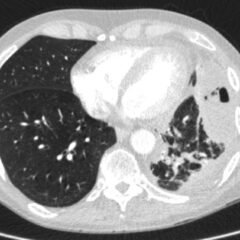Modified Manikin for Tracheoinnominate Artery Fistula
ABSTRACT:
Audience:
This simulator is designed to instruct emergency medicine residents in tracheostomy training that involves bleeding from the tracheostomy site. Any resident, fellow, or attending physician who cares for patients with complications from their tracheostomy might benefit from this innovation.
Introduction:
The emergency medicine provider must maintain proficiency in caring for patientswith complications from their tracheostomy. In the United States, over 110,000 patients receive tracheostomies per year.1 A rare but catastrophic complication of tracheostomies, usually within the first month of placement, is a tracheoinnominate artery fistula (TIAF). This complication occurs in 0.7% of tracheostomy patients and carries a 50-70% mortality.1,2 We modified a low-fidelity tracheostomy manikin to instruct learners in the stepwise management of hemorrhage from a TIAF.
Educational Objectives:
By the end of this educational session, learners will be able to: 1) perform a focused history and physical exam on any patient who presents with bleeding from the tracheostomy site; 2) describe the differential diagnosis of bleeding from a tracheostomy site, including a TIAF; 3) demonstrate the stepwise management of bleeding from a suspected TIAF, including cuff hyperinflation and the Utley Maneuver; 4) verify that definitive airway control via endotracheal intubation is only feasible in the tracheostomy patient when it is clear, upon history and exam, that the patient can be intubated from above; and 5) demonstrate additional critical actions in the management of a patient with a TIAF, including early consultation with otolaryngology and cardiothoracic surgery as well as emergent blood transfusion and activation of a massive transfusion protocol.
Educational Methods:
This modified manikin is a useful training tool for any healthcare provider who is involved in the treatment and stabilization of a variety of tracheostomy emergencies, from bleeding to infection to obstruction or dislodgement. Our case was presented on two separate occasions, to otolaryngology interns (PGY-1), and emergency medicine residents (PGY 1-3). It involved the care of a patient with a sentinel bleed and subsequent hemorrhage from a tracheoinnominate artery fistula (TIAF). This low-fidelity tracheostomy manikin provides the ideal platform for any complex, tracheostomy case, particularly where ongoing bleeding from the tracheostomy site might permanently damage the electrical circuitry of a high-fidelity model. We initially fashioned this modified manikin for tracheostomy training during a simulation “boot camp” for otolaryngology PGY-1 residents. Our use of this modified manikin for tracheostomy training was a useful teaching tool during our otolaryngology intern “boot camp.” As a result, we organized a subsequent simulation training session with our PGY 1-3 emergency medicine residents to provide similar instruction in management of a TIAF.
Research Methods:
We provided a pre- and a post-simulation survey for the 33 emergency medicine residents who participated in the TIAF simulation with our modified tracheostomy manikin. There were 11 residents from each of the PGY-1, PGY-2, and PGY-3 year-groups. Thirty-two residents (97%) completed the pre-simulation survey, and 33 residents (100%) completed the post- simulation survey. We used a 6-point Likert Scale from “strongly agree” to “strongly disagree” to assess a resident’s knowledge of multiple learning objectives within this simulation.
Results:
The pre- and post-simulation survey supported this simulation and manikin innovation as a useful teaching tool for tracheostomy emergencies such as a TIAF.
Discussion:
This was a useful innovation for emergency provider training in the recognition and management of a TIAF, a rare but emergent tracheostomy complication. In addition to this bleeding complication, this innovation might be useful for a variety of tracheostomy emergencies such as site infection, obstruction, and tube dislodgement. We highly recommend the involvement of both an emergency medicine and otolaryngology content expert in the design and debriefing of tracheostomy cases with this modified manikin. In our experience, a facilitated debriefing by an experienced clinician and educator from both fields provided a diverse perspective for challenging cases such as bleeding from a TIAF.
Topics:
Difficult airway, tracheostomy, tracheoinnominate fistula, hemorrhagic shock, tracheostomy complications, Utley Maneuver.

